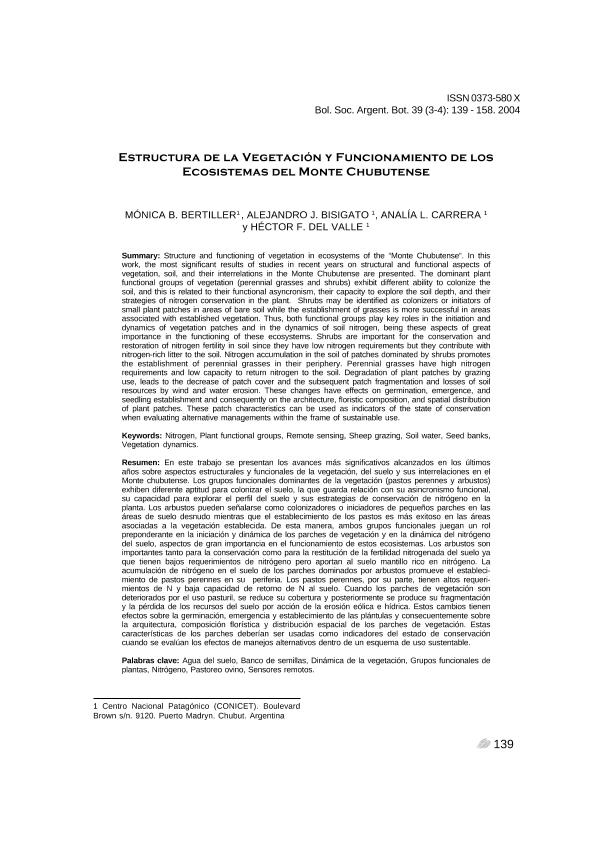Mostrar el registro sencillo del ítem
dc.contributor.author
Bertiller, Monica Beatriz

dc.contributor.author
Bisigato, Alejandro Jorge

dc.contributor.author
Carrera, Analía Lorena

dc.contributor.author
del Valle, Hector Francisco

dc.date.available
2020-05-04T18:10:52Z
dc.date.issued
2004-12
dc.identifier.citation
Bertiller, Monica Beatriz; Bisigato, Alejandro Jorge; Carrera, Analía Lorena; del Valle, Hector Francisco; Estructura de la vegetación y funcionamiento de los ecosistemas del Monte austral; Sociedad Argentina de Botánica; Boletín de la Sociedad Argentina de Botánica; 39; 3-4; 12-2004; 139-158
dc.identifier.issn
0373-580X
dc.identifier.uri
http://hdl.handle.net/11336/104161
dc.description.abstract
En este trabajo se presentan los avances más significativos alcanzados en los últimos años sobre aspectos estructurales y funcionales de la vegetación, del suelo y sus interrelaciones en el Monte chubutense. Los grupos funcionales dominantes de la vegetación (pastos perennes y arbustos)exhiben diferente aptitud para colonizar el suelo, la que guarda relación con su asincronismo funcional,su capacidad para explorar el perfil del suelo y sus estrategias de conservación de nitrógeno en la planta. Los arbustos pueden señalarse como colonizadores o iniciadores de pequeños parches en las áreas de suelo desnudo mientras que el establecimiento de los pastos es más exitoso en las áreas asociadas a la vegetación establecida. De esta manera, ambos grupos funcionales juegan un rol preponderante en la iniciación y dinámica de los parches de vegetación y en la dinámica del nitrógeno del suelo, aspectos de gran importancia en el funcionamiento de estos ecosistemas. Los arbustos son importantes tanto para la conservación como para la restitución de la fertilidad nitrogenada del suelo ya que tienen bajos requerimientos de nitrógeno pero aportan al suelo mantillo rico en nitrógeno. La acumulación de nitrógeno en el suelo de los parches dominados por arbustos promueve el establecimiento de pastos perennes en su periferia. Los pastos perennes, por su parte, tienen altos requerimientos de N y baja capacidad de retorno de N al suelo. Cuando los parches de vegetación son deteriorados por el uso pasturil, se reduce su cobertura y posteriormente se produce su fragmentación y la pérdida de los recursos del suelo por acción de la erosión eólica e hídrica. Estos cambios tienen efectos sobre la germinación, emergencia y establecimiento de las plántulas y consecuentemente sobre la arquitectura, composición florística y distribución espacial de los parches de vegetación. Estas características de los parches deberían ser usadas como indicadores del estado de conservación cuando se evalúan los efectos de manejos alternativos dentro de un esquema de uso sustentable.
dc.description.abstract
Structure and functioning of vegetation in ecosystems of the “Monte Chubutense“. In this work, the most significant results of studies in recent years on structural and functional aspects of vegetation, soil, and their interrelations in the Monte Chubutense are presented. The dominant plant functional groups of vegetation (perennial grasses and shrubs) exhibit different ability to colonize the soil, and this is related to their functional asyncronism, their capacity to explore the soil depth, and their strategies of nitrogen conservation in the plant. Shrubs may be identified as colonizers or initiators of small plant patches in areas of bare soil while the establishment of grasses is more successful in areas associated with established vegetation. Thus, both functional groups play key roles in the initiation and dynamics of vegetation patches and in the dynamics of soil nitrogen, being these aspects of great importance in the functioning of these ecosystems. Shrubs are important for the conservation and restoration of nitrogen fertility in soil since they have low nitrogen requirements but they contribute with nitrogen-rich litter to the soil. Nitrogen accumulation in the soil of patches dominated by shrubs promotes the establishment of perennial grasses in their periphery. Perennial grasses have high nitrogen requirements and low capacity to return nitrogen to the soil. Degradation of plant patches by grazing use, leads to the decrease of patch cover and the subsequent patch fragmentation and losses of soil resources by wind and water erosion. These changes have effects on germination, emergence, and seedling establishment and consequently on the architecture, floristic composition, and spatial distribution of plant patches. These patch characteristics can be used as indicators of the state of conservation when evaluating alternative managements within the frame of sustainable use
dc.format
application/pdf
dc.language.iso
spa
dc.publisher
Sociedad Argentina de Botánica

dc.rights
info:eu-repo/semantics/openAccess
dc.rights.uri
https://creativecommons.org/licenses/by-nc-sa/2.5/ar/
dc.subject
AGUA DEL SUELO
dc.subject
BANCO DE SEMILLAS
dc.subject
DINÁMICA DE LA VEGETACIÓN
dc.subject
GRUPOS FUNCIONALES DE PLANTAS
dc.subject
NITROGENO
dc.subject
PASTOREO OVINO
dc.subject
SENSORES REMOTOS
dc.subject
NITROGEN
dc.subject
PLANT FUNCTIONAL GROUPS
dc.subject
REMOTE SENSING
dc.subject
SHEEP GRAZING
dc.subject
SOIL WATER
dc.subject
SEED BANKS
dc.subject
VEGETATION DYNAMICS
dc.subject.classification
Otras Ciencias Agrícolas

dc.subject.classification
Otras Ciencias Agrícolas

dc.subject.classification
CIENCIAS AGRÍCOLAS

dc.title
Estructura de la vegetación y funcionamiento de los ecosistemas del Monte austral
dc.type
info:eu-repo/semantics/article
dc.type
info:ar-repo/semantics/artículo
dc.type
info:eu-repo/semantics/publishedVersion
dc.date.updated
2020-04-27T14:41:40Z
dc.identifier.eissn
1851-2372
dc.journal.volume
39
dc.journal.number
3-4
dc.journal.pagination
139-158
dc.journal.pais
Argentina

dc.conicet.avisoEditorial
Provee ACCESO ABIERTO y gratuito inmediato a su contenido bajo el principio de que hacer disponible gratuitamente la investigación al público, lo cual fomenta un mayor intercambio de conocimiento global.
dc.description.fil
Fil: Bertiller, Monica Beatriz. Universidad Nacional de la Patagonia. Facultad de Ciencias Naturales. Sede Puerto Madryn; Argentina. Consejo Nacional de Investigaciones Científicas y Técnicas. Centro Científico Tecnológico Conicet - Centro Nacional Patagónico; Argentina
dc.description.fil
Fil: Bisigato, Alejandro Jorge. Consejo Nacional de Investigaciones Científicas y Técnicas. Centro Científico Tecnológico Conicet - Centro Nacional Patagónico; Argentina
dc.description.fil
Fil: Carrera, Analía Lorena. Consejo Nacional de Investigaciones Científicas y Técnicas. Centro Científico Tecnológico Conicet - Centro Nacional Patagónico; Argentina
dc.description.fil
Fil: del Valle, Hector Francisco. Consejo Nacional de Investigaciones Científicas y Técnicas. Centro Científico Tecnológico Conicet - Centro Nacional Patagónico; Argentina
dc.journal.title
Boletín de la Sociedad Argentina de Botánica

dc.relation.alternativeid
info:eu-repo/semantics/altIdentifier/url/https://botanicaargentina.org.ar/estructura-de-la-vegetacion-y-funcionamiento-de-los-ecosistemas-del-monte-chubutense/
Archivos asociados
